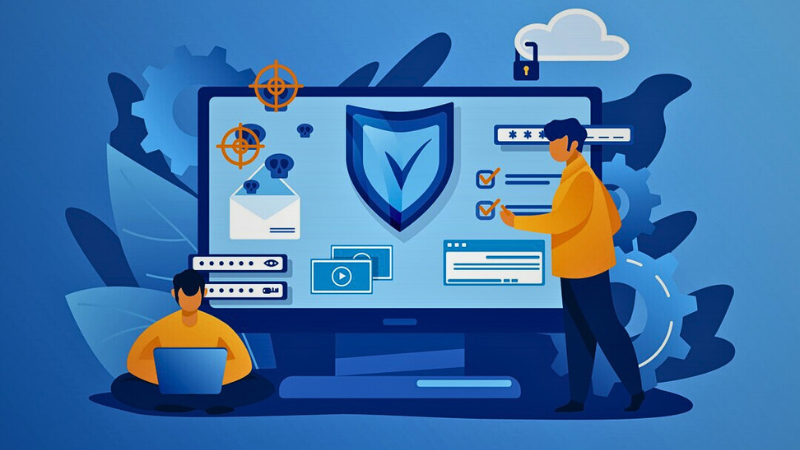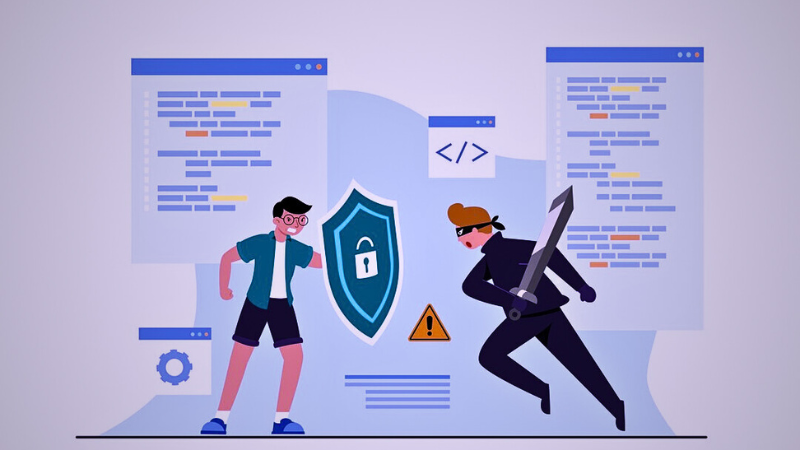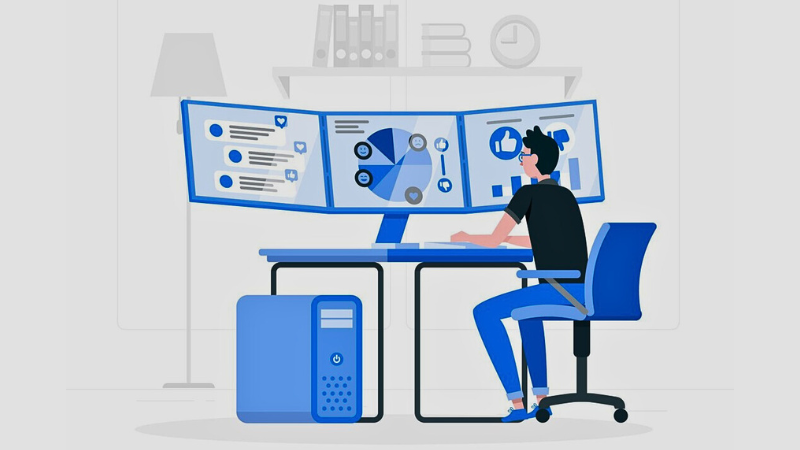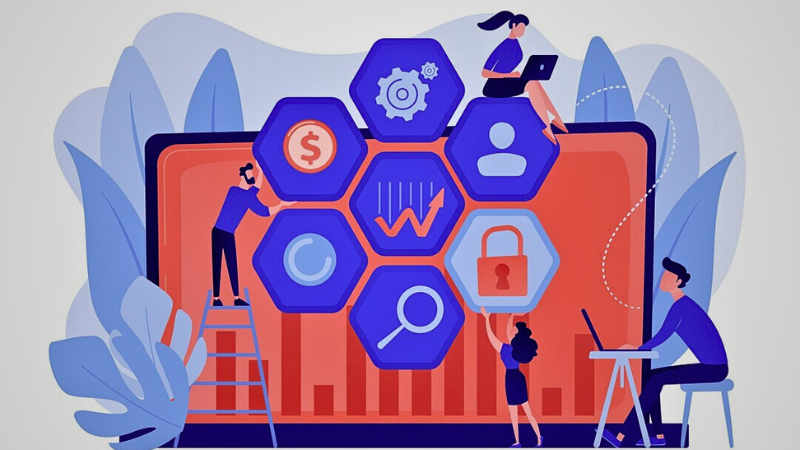Vulnerability management is an effective way to enhance the overall security posture of your organization.
With the growing cybersecurity concerns worldwide, it has become important to implement robust strategies and systems to secure your systems, network, and data from attackers.
It’s also crucial for you to enhance security awareness and give proper training to your employees so they can counter attacks or prevent them proactively.
In this article, I’ll discuss what vulnerability management is, its importance, the steps involved, and other details.
Stay tuned!
What Is Vulnerability Management?
Vulnerability management is a comprehensive cybersecurity program that involves detecting, prioritizing, evaluating, and addressing “vulnerabilities” or security weaknesses in an organization’s systems, devices, applications, and networks in order to keep them safe from data breaches and cyberattacks.

A vulnerability could be weaknesses like:
- Unpatched and outdated software
- Operation system misconfigurations
- Security misconfigurations
- Broken or missing authentication
- Poor or missing data encryption
- Human errors
- Risky third-party tools
Vulnerability management is a continuous and proactive process to facilitate security around the clock. It also involves monitoring your assets and devices continuously to identify issues and resolve them quickly.
The process aims at improving your organization’s security posture and reducing the attack surface and overall risks by finding and eliminating security weaknesses. It also allows you to stay updated with emerging security threats and protect your assets from them.
Today, the vulnerability management process has become easier with the introduction of various software solutions and tools to perform detection, assessment, and resolution at a single place. These systems can automate various steps of the process to save you time and effort that you can dedicate to framing strategies for enhancing your security posture.
Importance of Vulnerability Management
Several devices, systems, applications, networks, and appliances are used in an organization. These can have many security vulnerabilities that can get bigger with time and convert into a security threat.

There are many instances of negligence in security updates, misconfigurations, access management, patching, remediation, etc. Vulnerabilities like these can increase security risks as attackers can find and exploit them to carry a full-blown attack.
As a result, an organization can lose critical data, and their systems, apps, and devices can be compromised. This can pose many challenges in terms of finances, legal, and customer relationships.
This is what vulnerability management entails, allowing you to take a continuous proactive security approach and find and resolve vulnerabilities quickly to avoid mishaps.
Here are some of the benefits of vulnerability management for your organization.
Improved Visibility
With vulnerability management, you can get better visibility into all your systems, devices, networks, applications, and data, along with the vulnerabilities associated with them.
Using this insight, you can create a comprehensive system of reporting and tracking those vulnerabilities. This way, you can make better plans with your team to remediate those vulnerabilities and keep your assets secure.
Faster Threat Response

As explained above, vulnerability management gives you better insights into the vulnerabilities in your systems and networks. So, by identifying vulnerabilities, you can assess and address them proactively.
Since it’s a continuous process, you can keep monitoring vulnerabilities and fix them as soon as they appear. And even if an attack occurs, it will become easier for you to respond to them faster as opposed to the scenario when you do not have a vulnerability management program.
Meeting Compliance
Regulatory bodies like HIPAA, GDPR, PCI DSS, etc., have strict data privacy laws for organizations. And if an organization fails to meet these standards and requirements, it may get penalized.
Vulnerability management, when done effectively, can help you maintain regulatory compliance. This will enable you to assess and identify your vulnerabilities and patch them. You must also update the software on time, manage inventory properly, enable correct configurations, etc.
Enhanced Security Posture

A proper vulnerability management process can elevate the overall security posture of your organization, including all the assets and networks. Continuous monitoring will ensure no vulnerability goes undetected and quickly classify and fix issues before any attacker can exploit them.
Cost-Efficient
Vulnerability management can prove to be cost-efficient. The damage a cyberattack can do is much larger than implementing a vulnerability management process in an organization, even if you use dedicated tools.
Companies have lost millions to attacks, and the repair process is also hugely money-intensive.
So, instead of going through all that, you can deploy a proactive vulnerability management. It will help you prioritize high-risk vulnerabilities first to eliminate exploitation.
Maintained Trust
Improving security is not only good for your organization but also for your partners and customers. By implementing vulnerability management and security data and systems, you make yourself more reliable and trustworthy before your customers and partners.

Apart from the above, vulnerability management offers more benefits:
- It can reduce manual workflows and automate the monitoring, remediation, and alerting process
- Organizations can witness increased operational efficiencies.
- It can keep your teams aligned with your organization’s goals for security
Vulnerability Management Lifecycle
Vulnerability management involves certain steps or phases that form the vulnerability management lifecycle, from the moment they are discovered to their resolution and continuous monitoring.
#1. Discovery
In the first phase, you must create a complete list of all the assets in your organization. It could be your systems, devices, equipment, networks, applications, files, operating systems, hardware, and more.
These components can have certain vulnerabilities in them, like software updates, configuration mistakes, bugs, errors, etc., that cyber attackers want to exploit. In addition, these have business and customer data that attackers can gain access to and cause you harm.
So, apart from discovering your assets, you must also identify vulnerabilities in them. You can use vulnerability scanners for this purpose. You can also execute an audit to get a complete report on assets and vulnerabilities.
#2. Classification and Prioritization

Once you have detected the assets and vulnerabilities, group them based on their criticality and value in business operations. This way, you can prioritize the groups that demand immediate action so you can resolve them first before they pave the way to a security breach. Prioritizing the assets also comes in handy when allocating resources to each one of them.
#3. Assessment
In this phase, you must assess the risk profiles associated with each asset. For this, many organizations utilize the Common Vulnerability Scoring System (CVSS). This open and free standard can help you evaluate and understand the characteristics and severity of each software vulnerability.
According to CVSS, the Base Score varies from 0 to 10. The National Vulnerability Database (NVD) assigns the severity grade to CVSS scores. In addition, the NVD contains data pulled by IT staff and automated solutions for vulnerability management.
Here’s how CVSS scores are given:
- 0 – None
- 0.1-3.9 – Low
- 4.0-6.9 – Medium
- 7.0-8.9 – High
- 9.0-10.0 – Critical
So, when assessing the vulnerabilities, consider the classification of assets, exposure to security risks, and criticality. This will also help you figure out which assets to fix first.
#4. Reporting
Now that you have assessed each vulnerability and asset in your organization, document them and report them to the decision-makers. You can highlight the risk level for each asset depending on the assessment you have completed.

You can also submit activity reports every week, twice a month, or every month. This will help you stay updated with each vulnerability and ensure nothing is left undocumented.
In addition, you must put forward your strategy to remediate the known vulnerabilities. It will give an idea to your team on how to proceed with the resolution and accelerate the process.
#5. Remediation
In this stage, you and your team must have complete details on the assets and vulnerabilities, along with the priority levels for each asset.
By now, your team must come to a conclusion on how to deal with each vulnerability and what tools and techniques to use. Each team member must clearly understand their roles and responsibilities. This not only includes the cybersecurity teams but also IT, operations, public relations, finance, legal, etc. You must also get buy-in from stakeholders and clients,
Once everything is set, start fixing the vulnerabilities that are most critical for your organization. Although you can do it manually, using tools can automate and accelerate the whole process and save you plenty of time, effort, and resources.
#6. Reassessment

When you have resolved all the known vulnerabilities in your systems, devices, networks, and applications, it’s time to reassess them. You must carry out audits to reassess and ensure that all the vulnerabilities are eliminated.
This enables you to spot remaining issues, if any, and remove them. You must also keep following up with your team to know the status of vulnerabilities and assets.
#7. Monitoring and Improvement
The vulnerability management cycle does not end with you fixing the known vulnerabilities in your system. Instead, it’s a continuous process that requires you to continuously monitor your network and systems to detect vulnerabilities and fix them before any attacker exploits them.
This way, the cycle of vulnerability management keeps on continuing. You must carry on detecting, prioritizing, assessing, resolving, reassessing, and monitoring vulnerabilities in order to secure your network, data, and systems and improve your overall security posture.
In addition, you must also keep yourself and your team updated with the latest threats and risks to fight against them proactively if they surface.
Vulnerability Management vs. Penetration Testing
Many confuse vulnerability management or assessment with penetration testing. The reason could be many things, like both are security-related techniques where the aim is to secure an organization’s data, systems, and users from cyberattacks.

However, penetration testing is different from vulnerability management in many ways. Let’s understand how.
Penetration testing is a type of software testing that replicates the activities or actions of internal or external cyber attackers who intend to breach an organization’s network and security measures and gain access to critical data or hinder operations.
This testing is carried out by a penetration tester or ethical hacker using advanced techniques and tools.
In contrast, vulnerability management is not a single process but a continuous process that involves identifying vulnerabilities and prioritizing, assessing, and resolving them, along with reporting and monitoring them continuously.
It aims at removing each vulnerability from an organization’s systems, devices, applications, etc., so that no attacker can leverage them and turn them into a cyberattack.
| Vulnerability Management | Penetration Testing |
|---|---|
| It involves identifying all the assets and vulnerabilities in systems. | It involves determining the scope of a cyberattack. |
| It assesses the risk level associated with each vulnerability for the organization. | It tests the collection of sensitive data. |
| It aims to remove all the vulnerabilities from systems and devices. | It aims at cleaning up a given system and documenting it in a report. |
| You can audit and analyze all the systems and vulnerabilities to understand your attack surface. | You conduct penetration on a given software solution or system to understand the risks. |
| It’s a continuous process. | It’s not a continuous process but is performed when you want to know how a system would react to a cyber threat. |
Challenges in Vulnerability Management

While implementing vulnerability management, many organizations face certain challenges. These are:
- Limited resources and time: Organizations have limited resources and time for vulnerability management. The employees are not available all the time to track changes, report, and mitigate issues. But attackers don’t rest even on holidays or weekends. Thus, attacks can happen anytime if the vulnerabilities are not dealt with in time.
- Improper prioritization: Sometimes, decision-makers prioritize vulnerabilities to be fixed based on certain biases that can cloud their decisions. And if a critical vulnerability is left unaddressed, it can quickly turn into a cyber breach.
- Using risky third-party tools: Many organizations have suffered enormously by using risky third-party tools for patching. It not only increases the attack surface but also makes the workflow inefficient.
- Manual process: Many organizations still prefer tracking and resolving vulnerabilities manually. This could set the ground for errors and inefficiencies and increase risks. Also, if there are too many security weaknesses to be tracked and resolved, the process can get inefficient, and the attackers can leverage those vulnerabilities before you resolve them.
Therefore, it’s beneficial to use safer vulnerability management tools to automate these processes.
Tools for Vulnerability Management
Vulnerability management solutions are tools that can automate various parts of the vulnerability management lifecycle. There are tools for monitoring, detecting, and eliminating vulnerabilities, along with reporting, alerting, and more.
Some tools you can consider are:
- ManageEngine Vulnerability Manager Plus
- Astra Pentest
- Rapid7 InsightVM
- Heimdal Patch & Asset Management
- Qualys Cloud Platform
- CrowdStrike Falcon
- Automox
Using them, you can save a lot of resources, time, and effort while getting accurate visibility and remediation in a single place.
Best Practices for Implementing Vulnerability Management

Here are some of the best practices you can consider while implementing vulnerability management in your organization.
- Perform thorough scanning: To eliminate all critical vulnerabilities in your entire network, you must thoroughly scan each endpoint, device, system, service, and application. For this, you can first identify all the assets and then find vulnerabilities in each of them.
- Continuous monitoring: Enable a system to perform continuous monitoring and scanning of your assets so that issues can be registered as soon as they pop up. You can also use some tools to schedule and scan your systems every week or month to stay updated with vulnerabilities.
- Prioritize properly and ensure accountability: Prioritize your vulnerabilities and assets properly without any biases. You must also appoint owners to your critical assets so that they can take accountability for keeping the assets in the best condition and regularly patching them.
- Document properly: Documentation and reporting are often overlooked by many. So, document all the vulnerabilities with their associated assets, timeline, and results. This will help you remediate similar instances quickly.
- Training and awareness: Train your employees and make them aware of the latest trends and threats in cybersecurity. You must also empower them with the proper tools so they can become more productive and proactive at identifying and resolving security weaknesses.
Conclusion
I hope the above information helps you understand vulnerability management and ease the implementation process to enhance security.
To make the process more efficient, you can use vulnerability management solutions to perform proactive identification and remediation of vulnerabilities in your system and network.
You may also explore some best vulnerability management software.

